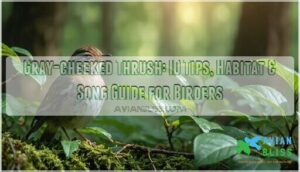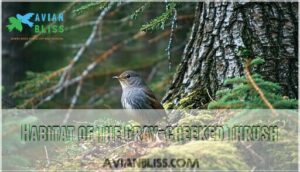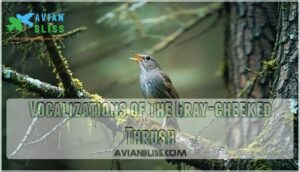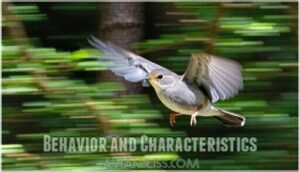This site is supported by our readers. We may earn a commission, at no cost to you, if you purchase through links.
 You’ll identify the gray-cheeked thrush by its olive-brown upperparts, heavily spotted breast, and distinctive gray cheek patches that lack the warm buff tones of its close relatives.
You’ll identify the gray-cheeked thrush by its olive-brown upperparts, heavily spotted breast, and distinctive gray cheek patches that lack the warm buff tones of its close relatives.
This arctic breeder stands out from other spotted thrushes through its cooler coloration, minimal eye-ring, and preference for dense understory during migration.
When spring and fall arrive, you’ll find these elusive birds moving through North American woodlands in what feels like a secretive game of hide-and-seek.
Their ethereal, ascending song spirals upward like smoke, often the only clue to their presence in thick cover.
The key lies in recognizing those subtle gray cheeks that give this species away.
Table Of Contents
- Key Takeaways
- Identification of The Gray-cheeked Thrush
- Differences From Swainson’s Thrush
- Habitat of The Gray-cheeked Thrush
- Vocalizations of The Gray-cheeked Thrush
- Behavior and Characteristics
- Frequently Asked Questions (FAQs)
- Where can I see Gray-cheeked Thrushes?
- How do I attract Gray-cheeked Thrushes to my yard?
- What is the difference between Swainson’s thrush and GREY cheeked thrush?
- Are Gray-cheeked Thrushes endangered?
- How do you identify Gray-cheeked Thrush?
- Where does the GREY cheeked thrush live?
- What is the song of the GREY cheeked thrush?
- How does climate change affect Gray-cheeked Thrush?
- What research is currently being conducted on Gray-cheeked Thrush?
- What are the major threats to Gray-cheeked Thrush habitats?
- Conclusion
Key Takeaways
- You’ll identify gray-cheeked thrushes by their distinctive gray cheek patches, olive-brown upperparts, and cooler coloration compared to other spotted thrushes – look for the incomplete white eye-ring that’s strongest behind the eye.
- You can distinguish them from Swainson’s thrush by noting gray-cheeked lacks the prominent buff eye-ring and shows grayer, colder tones instead of Swainson’s warmer olive-brown appearance.
- You’ll find these elusive birds in dense boreal forests from Alaska to Newfoundland during breeding season, then catch glimpses during migration through eastern woodlands as they move to South American wintering grounds.
- You’ll recognize their ethereal, ascending song that spirals upward with thin whistles ending abruptly – often your only clue to their presence since they prefer thick cover and secretive behavior.
Identification of The Gray-cheeked Thrush
Identifying a gray cheeked thrush requires careful attention to several key field marks.
You’ll need to focus on the eyering shape, which appears incomplete and whitish, most prominent behind the eye but absent or weak below.
The breast spotting consists of blackish triangular marks that stop abruptly at the breast, changing to gray on the flanks.
This flank color difference is essential—unlike other thrushes, the gray-cheeked shows unspotted gray-olive flanks rather than buff tones.
Wing structure provides the most reliable identification feature, with longer primary projection and only two clearly emarginated feathers.
Tail color won’t help much since it lacks the reddish tones of Hermit Thrush.
These bird identification features work together as a package—no single field mark guarantees accurate thrush identification.
Beginners may find it helpful to consult bird identification basics for more general guidance.
Differences From Swainson’s Thrush
Separating Gray-cheeked Thrush from Swainson’s thrush requires sharp observation skills. The eye ring serves as your primary clue—Gray-cheeked lacks the distinct buffy spectacles that make Swainson’s appear alert and marked. Plumage comparison reveals Gray-cheeked’s colder, steel-gray appearance versus Swainson’s warmer olive-brown tones. Song analysis provides another reliable identifier during migration.
Here’s what to watch for in the field:
- Face patterns: Gray-cheeked shows fine gray lines through plain cheeks, while Swainson’s displays continuous buff coloring around the eye and lores
- Breast markings: Gray-cheeked has fewer, paler chest spots compared to Swainson’s more contrasting pattern
- Overall warmth: Swainson’s appears consistently warmer with buffy washes, while Gray-cheeked maintains cooler, uniform tones throughout
Range overlap occurs during migration, making careful thrush identification essential for accurate bird identification. The female Gray-cheeked Thrush builds a nest of grass and moss.
Habitat of The Gray-cheeked Thrush
You’ll discover the Gray-cheeked Thrush across some of North America’s most remote wilderness areas.
These secretive birds stake out their Breeding Grounds in northern boreal forests and taiga from Alaska to Newfoundland, often near the treeline where dense coniferous forests meet willow and alder thickets.
Bird habitat preferences include stunted spruce and fir stands on windblown sites, plus shrubby woodlands with well-developed understory layers.
During Migration Routes, you’ll find them in eastern U.S. woodlands with abundant fruit.
Their Wintering Habitat spans northern South America’s humid tropical forests and dense thickets.
The Graycheeked Thrush faces challenges from Habitat Loss in old-growth forest habitats and potential Climate Impact on boreal bird breeding range accessibility.
These habitat preferences make conservation efforts essential for maintaining stable populations across their extensive range.
They’re known to utilize thickets on the tundra for nesting in their northernmost breeding areas.
Vocalizations of The Gray-cheeked Thrush
You’ll recognize the Gray-cheeked Thrush’s song structure immediately once you hear its distinctive thin, rising whistles that end abruptly, creating a less melodic sound compared to other thrush species.
Each phrase lasts just 1-2 seconds and contains 3-7 notes that typically start low, rise sharply, then drop suddenly.
The bird’s call types include a harsh "veeah" note and a sharp, nasal "peeew" flight call during migration, serving specific song functions – males use songs for territory defense and mate attraction, while call notes maintain flock cohesion.
Bird songs from this species peak during late May breeding season, with young birds practicing vocal learning through late summer.
Unlike some species, Gray-cheeked Thrush vocalizations show minimal regional dialects across their range, and their vocalizations are influenced by habitat acoustic properties, affecting frequency and clarity.
Behavior and Characteristics
Beyond their distinctive songs, the Gray-cheeked Thrush (Catharus minimus) displays fascinating behavioral patterns across varied habitats.
These elusive birds reveal their secrets through patient observation and careful attention to subtle field marks.
You’ll observe their foraging habits involve methodical ground-hopping under dense cover, occasionally vibrating feet to disturb insects.
Their alarm calls serve as crucial warning signals to nearby birds.
Key behavioral highlights include:
- Migration patterns spanning 5,000 kilometers from northern breeding grounds to South American wintering areas
- Physical attributes enabling swift courtship flights through dense forest canopy
- Subspecies traits affecting territorial displays, with "Northern" populations showing different intensity levels
During breeding season, males establish territories through vocalizations before females arrive.
Both subspecies exhibit cryptic responses to threats, freezing motionless rather than fleeing.
Their flight patterns demonstrate remarkable agility during territorial disputes and courtship chases through thick vegetation.
Nesting behavior shows females constructing cup-shaped structures low in conifers, typically under 10 feet high.
Frequently Asked Questions (FAQs)
Where can I see Gray-cheeked Thrushes?
Chasing these elusive songbirds feels like hunting ghosts through dense forests.
You’ll find them in boreal woodlands across Canada and Alaska during breeding season, then catch glimpses during spring and fall migration through eastern North America, which can be a thrilling experience, especially when you finally spot one of these songbirds.
How do I attract Gray-cheeked Thrushes to my yard?
Create dense ground cover with native shrubs like elderberry and serviceberry. Plant fruit-bearing trees including hawthorn and chokecherry. Maintain quiet, undisturbed areas with thick understory vegetation where they’ll forage naturally.
What is the difference between Swainson’s thrush and GREY cheeked thrush?
You’ll spot the key difference in their eye rings: Swainson’s has a prominent, complete buff-colored eye ring, while Gray-cheeked lacks this distinctive feature, showing only faint markings behind the eye.
Are Gray-cheeked Thrushes endangered?
Despite concerns about population decline, these birds aren’t endangered.
They’re currently listed as "Least Concern" by the IUCN, though you’ll find about 46 million breeding globally with habitat loss as their main challenge.
How do you identify Gray-cheeked Thrush?
Look for an incomplete white eye ring that’s strongest behind the eye, plus gray-olive flanks with triangular breast spots that don’t extend past the chest area.
Where does the GREY cheeked thrush live?
You’ll find Gray-cheeked Thrushes breeding across northern Canada and Alaska’s boreal forests. During winter, they migrate to Central and South America’s tropical lowlands, particularly following army ant swarms.
What is the song of the GREY cheeked thrush?
Like a woodwind’s gentle whisper through forest halls, you’ll hear the gray-cheeked thrush’s ethereal song—a thin, nasal phrase spiraling upward with delicate notes that seem to float on air.
Often ending with a questioning inflection.
How does climate change affect Gray-cheeked Thrush?
Climate change disrupts your migration routes, shrinks available breeding habitat in Canada and Alaska by thirty percent, and affects food sources throughout your journey.
What research is currently being conducted on Gray-cheeked Thrush?
Scientists need dusty research tomes like knights need armor – urgent studies examine migration routes, habitat loss impacts, and genetic differences between subspecies.
You’ll find this songbird remains one of North America’s least-studied species, with researchers tracking population declines and studying its remote breeding territories.
What are the major threats to Gray-cheeked Thrush habitats?
You’re facing habitat loss from climate change, deforestation for logging and agriculture, oil and gas exploration, and urban development.
Mining, ecosystem changes, and altered migration timing also threaten these birds’ survival throughout their range.
Conclusion
Mastering the gray-cheeked thrush requires patience and persistence.
You’ll develop sharper identification skills by focusing on those distinctive gray cheek patches and cooler tones.
Practice distinguishing their ethereal song from similar species during migration seasons.
Remember that these arctic breeders prefer dense cover, making every sighting rewarding.
With dedication, you’ll transform from struggling with warbler confusion to confidently identifying this elusive gray-cheeked thrush among North America’s spotted thrushes.
- https://www.allaboutbirds.org/guide/Gray-cheeked_Thrush/species-compare/
- https://swiftbirder.wordpress.com/2011/04/06/comparison-of-north-american-spotted-thrushes/
- https://www.audubon.org/field-guide/bird/gray-cheeked-thrush
- https://www.gov.nl.ca/ffa/files/wildlife-endangeredspecies-ssac-gray-cheeked-thrush-2005-ssac.pdf
- https://conservewildlifenj.org/?species=catharus-minimus






